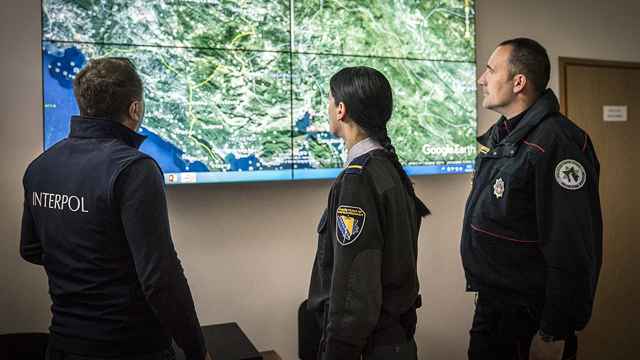On Nov. 25, the State Duma approved in the key second reading two amendments to the federal law on cultural heritage. If passed in the final reading Dec. 13, they would pave the way for the destruction of Russia’s remaining architectural heritage. One of the changes would legalize the “reconstruction” of architectural monuments, while the second would make it possible for the Culture Ministry, instead of the government, to remove a federal architectural monument from the state register. Once a building loses its status as a protected monument, obtaining permission for demolished becomes easy. Either of these changes alone would jeopardize Russia’s cultural legacy, but together they may be catastrophic. Lawmakers are essentially providing two legitimate ways to replace an original historic building with a sham replica.
The present law does not permit “reconstruction,” although the practice was widespread during the tenure of former Mayor Yury Luzhkov. High-profile buildings in Moscow that were treated in this way include: Hotel Moskva (constructed 1932-38, demolished 2003, planned to reopen 2011); the Voyentorg department store (constructed 1912-14, demolished 2003, reopened 2008); the Rimsky Korsakov Quarter, now the Turandot restaurant (late 18th-century ensemble of buildings, demolished 2004, opened 2006), and Tsaritsyno Palace (late 18th-century building that was never completed and became a ruin, which opened in 2007 with a new roof and interiors).
The rise of the sham replica has been accompanied by increased demolitions. From 1992 to 2007, Moscow lost more than 2,000 buildings, at least 200 of which were listed architectural monuments or newly declared monuments. Property developers do not like the law now because it protects monuments from distortion and demolition. Even so, developers and Luzhkov have found ways around the protections when they have most wanted it. Of the above examples, only the demolition of the Moskva was legal, while the others involved maneuvers to sidestep the law.
Legitimizing reconstructions would mean giving state approval to the practice, despite opposition from restorers, architectural historians and preservation campaigners, who this week sent an appeal to President Dmitry Medvedev. It would also fly in the face of the 1972 UNESCO Convention Concerning the Protection of the World Cultural and Natural Heritage, which the Soviet Union ratified in 1988. This was based on the Venice Charter of 1964, which does not allow reconstructions.
Reconstruction makes possible all of the chief threats that architectural heritage faces. The process may include changing the height, volume or total area of a building by adding stories, both underground and above. Also, the replacement of original building materials and technologies creates a different texture, color and appearance. For those who believe that the value of a building is in its materials, like the grandfathers of conservation, John Ruskin and William Morris, founders of the Society for the Protection of Ancient Buildings in Britain in 1877, the sham replica is a threat to the fundamentals of conservation philosophy. The society believes that, “Old buildings cannot be preserved by making them new.”
By depriving the cityscape of authentic historical buildings, Moscow’s sham replicas are distorting its citizens’ and visitors’ sense of place and history. Visitors to Tsaritsyno do not know what is old and what is new; they do not know that the interiors and roof are a 21st-century fantasy. When I visited Turandot in 2007, the maitre d’ said to me, with a great flourish, “I see that you are admiring the decoration. Everything here is authentic.” And he really believed that, even though the $50 million reconstruction is a fabrication.
While the campaign to save Moscow’s buildings has always been hard going, at least it has had the law on its side. These amendments make a mockery of Russia’s sophisticated heritage laws, effectively rendering them impotent.
Luzhkov once claimed that he was righting historical wrongs by reconstructing monuments destroyed by the Soviets. But today’s political and business landscape indicates that a prime motivation is profit and convenience. As the former director of the Institute for Art History, Alexei Komech once said: “Soon we will have the youngest heritage of any city in the world.”
Clementine Cecil is co-founder of MAPS, the Moscow Architecture Preservation Society.
A Message from The Moscow Times:
Dear readers,
We are facing unprecedented challenges. Russia's Prosecutor General's Office has designated The Moscow Times as an "undesirable" organization, criminalizing our work and putting our staff at risk of prosecution. This follows our earlier unjust labeling as a "foreign agent."
These actions are direct attempts to silence independent journalism in Russia. The authorities claim our work "discredits the decisions of the Russian leadership." We see things differently: we strive to provide accurate, unbiased reporting on Russia.
We, the journalists of The Moscow Times, refuse to be silenced. But to continue our work, we need your help.
Your support, no matter how small, makes a world of difference. If you can, please support us monthly starting from just $2. It's quick to set up, and every contribution makes a significant impact.
By supporting The Moscow Times, you're defending open, independent journalism in the face of repression. Thank you for standing with us.
Remind me later.





